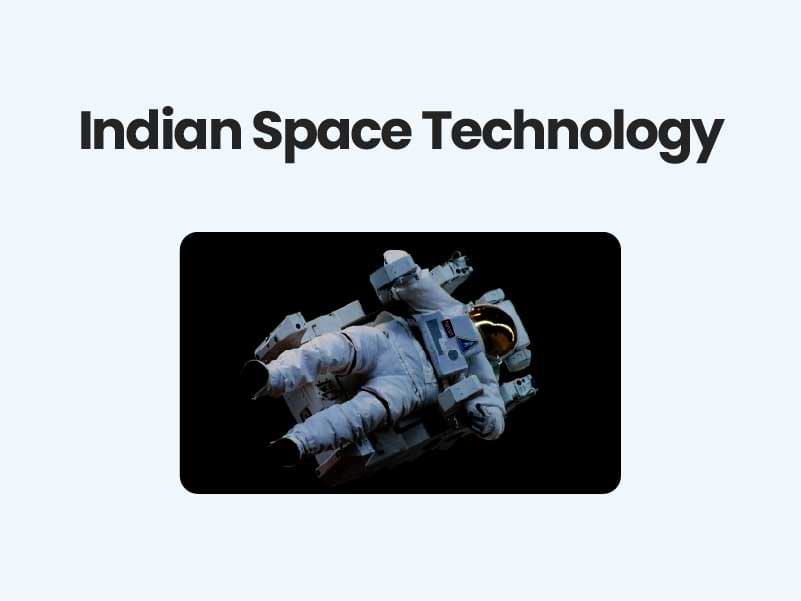Companion@360 → 7 Month programme to sharpen your writing skills → REGISTER NOW

ISRO and Indian Space Technology
India decided to go to space when the Indian National Committee for Space Research (INCOSPAR) was set up by the Government of India in 1962. With the visionary Dr Vikram Sarabhai at its helm, INCOSPAR set up the Thumba Equatorial Rocket Launching Station (TERLS) in Thiruvananthapuram for upper atmospheric research.
Vikram Sarabhai, having identified the role and importance of space technology in a Nation’s development, provided ISRO the necessary direction to function as an agent of development. ISRO then embarked on its mission to provide the Nation space-based services and to develop the technologies to achieve the same independently. The INCOSPAR was initiated under the leadership of Dr. Sarabhai and Dr. Ramanathan.
In the process, it has become one of the six largest space agencies in the world. ISRO maintains one of the largest fleet of communication satellites (INSAT) and remote sensing (IRS) satellites, that cater to the ever-growing demand for fast and reliable communication and earth observation respectively.
Indian Space Technology – Importance
- ISRO develops and delivers application-specific satellite products and tools to the Nation: broadcasts, communications, weather forecasts, disaster management tools, Geographic Information Systems, cartography, navigation, telemedicine, dedicated distance education satellites being some of them.
- To achieve complete self-reliance in terms of these applications, it was essential to develop cost efficient and reliable launch systems, which took shape in the form of the Polar Satellite Launch Vehicle (PSLV).
- The famed PSLV went on to become a favoured carrier for satellites of various countries due to its reliability and cost-efficiency, promoting unprecedented international collaboration. The Geosynchronous Satellite Launch Vehicle (GSLV) was developed keeping in mind the heavier and more demanding Geosynchronous communication satellites.
- Various dedicated research centres and autonomous institutions for remote sensing, astronomy and astrophysics, atmospheric sciences and space sciences in general function under the aegis of the Department of Space.
- ISRO’s own Lunar and interplanetary missions along with other scientific projects encourage and promote science education, apart from providing valuable data to the scientific community which in turn enriches science.
- ISRO is moving forward with the development of heavy-lift launchers, human spaceflight projects, reusable launch vehicles, semi-cryogenic engines, single and two-stage to orbit (SSTO and TSTO) vehicles, development and use of composite materials for space applications etc.
Applications
- Earth Observation Applications:
- Earth Observation Satellites of ISRO has been successfully able to establish many operational applications in the country. Both at Central and State level, there is a large number of users who utilise space-based inputs for various purposes.
- Some of the important missions of ISRO, in terms of IRS series of satellites, that has enabled unique applications of space-based imaging are, Cartosat-1 & 2, Resources at-1 & 2, Oceans-1 & 2, Risat-1, Megha-Tropiques, SARAL, Scatsat, INSAT series, and host of other satellites.
- ISRO is in the verge of realising next generation of these satellites, as part of a continuity of missions, to ensure that the user community is continuously benefitted from space inputs for sustainable development and good governance.
- Disaster management support:
- In order to better understand the risks due to disasters like floods, landslides, cyclones, forest fires, earthquakes, drought etc, it is necessary to integrate satellite and field-based observations and to work towards risk reduction principles.
- Disaster Management Support (DMS) Programme, comprehensively addresses various aspects of natural disasters in the country, using space-based inputs. ISRO disseminates relevant information in the interactive geospatial domain through various geo portals like Bhuvan, National Database for Emergency Management and MOSDAC for the administrators to better understand the impact and for improved decision support.
- ISRO provides the satellite-based near real-time information support to Central Ministries / Departments and State Ministries / Departments, prior during and after major natural disasters. In addition, ISRO also provides capacity building in the use of Space technology inputs in Disaster Management Support.
- ISRO is actively involved with various other countries with regard to disaster management, through international frameworks, such as International Charter ‘Space & Major Disasters’, Sentinel Asia, UNESCAP and so on.
- Satellite Communication:
- It has become widespread and ubiquitous throughout the country for such diverse applications like Television, DTH Broadcasting, DSNG and VSAT to exploit the unique capabilities in terms of coverage and outreach. The technology has matured substantially over past three decades and is being used on a commercial basis for a large number of applications.
- Important initiatives pursued by ISRO towards societal development include Tele-education, Tele-medicine, Village Resource Centre (VRC) and Disaster Management System (DMS) Programmes. The potential of space technology for applications of national development is enormous.
Role of ISRO in Indian space technology
- India is still is a developing country with vast developmental and security concerns. In this context, it is very difficult to justify the allocations for space missions that do not have a direct bearing on development. Successfully launched of MOM and a planned rover onto the moon surely boosted the Indian space program. But India’s reliance on satellites has created military vulnerabilities.
- India holds the view that reliance on the integration of outer space and cyber capabilities will only increase in future conflicts. But now beyond the maritime domain, India has been relying on foreign partners for many other satellite-based communications and data services. For instance, it continues to rely on NASA for deep space communications.
Read Also The Vedic Culture
Involvement of the private sector with ISRO
Advantages
- This attempts to increase the number of satellite launches and also explore more research-related opportunity areas in order to overcome manpower and budgetary constraints.
- The private sector would be responsible for the AIT (Assembly, Integration and Testing ) of satellites at ISRO facilities.
- The private sector already supplies the majority of the sub-systems in satellite manufacturing. This will let the private industry build their own facilities after gaining enough expertise.
- ISRO ‘s in-house capacity is limited so they can offload 30-40% of the work to the private sector.
- The collaboration with private players is vital for capacity building, cost reduction and getting an extra mile cutting-edge advantage.
- iSRO has 42 operational satellites for multiple purposes, including remote sensing, navigation, and communications that exclusively focus on India-centric needs. But in the coming years, a rapid surge in the number of satellites is almost certain. To cater to the rapidly changing technological scenarios and to contribute to digitalization, teaming with the private sector is the way ahead.
- ISRO is making a lot of satellites, and a large chunk of its manpower is involved in manufacturing and launch vehicles, so active involvement of the private sector would also mean that ISRO can devote more time to core research.
- A satellite needs mechanical structures, deployment mechanisms, thermal systems, solar panels, communication systems, so on and so forth. There are different companies which have been established by ISRO to take care of different subsystems
Disadvantages
- By 2020, ISRO plans to privatize PSLV launches. In future, the entire manufacture and launch of the PSLV could be handed over to the private sector.
- 90% of the work that has been subcontracted has been to the private sector, particularly in the satellite domain.
- It has serious national security implications.
- Without a proper governance framework, they lack a firm basis to operate in India and thus find it hard to attract private investment.
Read Also Anti Defection Law in India

